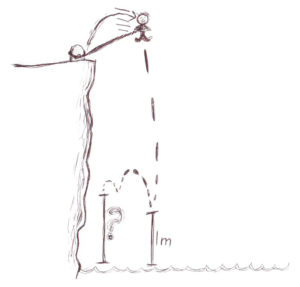
So, we’re trying to find Bob’s final height after his bungee jump. The spring constant of C5H8, normal rubber, is ≈88. The equation for the force is 1/2 kx2, where k is the spring constant and x is the portion of the natural length. When Bob begins his jump, the rubber is inactive. It’s length is zero. Thus the force of it’s pull is ≈88*02. But gravity pulls down with a force of ≈9.807 m/s2. After this we cannot continue. The simplest way is to code. Simulate the bungee jump in many microscopic steps. Calculate the pull of the elastic at each point. This will show where the lowest point of the jump is. The stable point is easily calculated. 44x2≈9.807. x2≈9.807 / 44 ≈ 0.2229. x ≈ 0.4721. The bottom of the jump is a whopping 101.7 metres down, making the answer ≈102.3 metres above the water.
PE=\frac{kx^2}2\\[16pt] 44x^2=9.807\\ x=0.4721\\[16pt] h_f=\Delta x+\approx0.5279m\\ \quad h_f=h_i-\approx0.4721m\because h_i=\Delta x+1m\\ \Delta x=101.7m\\ \Rightarrow h_i=101.7m+1m\\ \therefore h_f=101.7m+0.5279m=102.3m